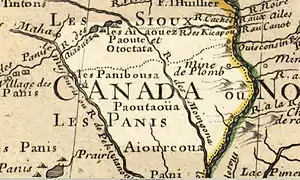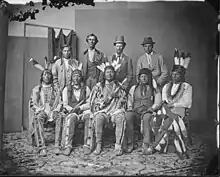American Indians of Iowa
American Indians of Iowa include numerous Native American tribes and prehistoric cultures that have lived in this territory for thousands of years.[1][2][3] There has been movement both within the territory, by prehistoric cultures that descended into historic tribes, and by other historic tribes that migrated into the territory from eastern territories. In some cases they were pushed by development pressure and warfare.
| Part of a series on |
| Native Americans in the United States |
|---|
Prehistoric period
Chiwere-Siouan speaking tribes
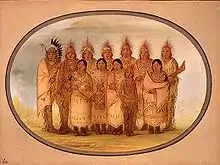
The Chiwere-speaking tribes are descended from the prehistoric Oneota culture. At the time of contact with European explorers, their range covered most of Iowa. The Ho-Chunk ranged primarily east of the Mississippi in southern Wisconsin, the Ioway/Baxoje ranged in northern Iowa, the Otoe in central and southern Iowa, and the Missouria in far southern Iowa.[4][5][6] All these tribes were also active during the historic period.
Dhegihan-Siouan speaking tribes
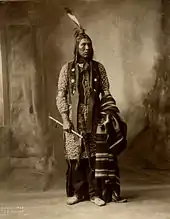
The following tribes arrived in the late prehistoric period:
The Dhegiha lived near the Missouri in the very Late Prehistoric and historic periods; they appear to have migrated to the region from the south or southeast. Their origin location is debated.[7][8]
Other Siouan-language-speaking tribes
The following tribes are of the late prehistoric and historic period:
These may be descendants of Late Prehistoric Mill Creek cultures, whose range extended into northwest Iowa.[2] Their territory was wide; the Lewis and Clark expedition reported on Mandan villages on the upper Missouri River.
Dakotan-Siouan speakers
The Dakota pushed southward into much of Iowa in the 18th and 19th centuries. They were frequently seen by European-American settlers.[3] In 1840, the translator Isaac Galland noted several Sioux groups in or near Iowa, including Wahpekute, North Sisseton, South Sisseton, East Wahpetonwan, West Wahpetonwan, Yankton, and Mdewakantonwan.[9]
Historic period
Caddoan-speaking tribes
These may be descendants of Late Prehistoric Central Plains Tradition cultures that lived in southwest Iowa, especially around the present-day Glenwood area. The Pawnee (Panis) are shown in southwest Iowa in a 1798 map, although they ranged primarily to the west.[2]
Algonquian speakers

Tribes from the early historical period:
- Illinois Confederacy (including Moingona, Peoria, and Piankashaw)
- Kickapoo. A subgroup occupied the Upper Iowa River region in the late 1600s and early 1700s; they may have been called the "Mahouea".[10]
- Mascouten
- Meskwaki (Fox)
- Sauk
The encroachment of Europeans and long-term conflict among Algonquian and Iroquoian tribes in the east pushed many eastern tribes into the Midwest. The Meskwaki have maintained a presence in Iowa, even after official removal in 1846. They established a recognized Settlement.[1][3]
Iroquoian speakers
The Wyandot (Huron) were Iroquoian speakers from the early historical period. Again, the encroachment of Europeans and long-term conflict between Algonquian and Iroquoian tribes in the east pushed these tribes into the Midwest.[1][3]
Moved into Iowa

These tribes moved to Iowa during the historic period:
- Potawatomi
- Ojibwe (Chippewa)
- Odawa (Ottawa)
The forced relocation of tribes in the 19th century from east of the Mississippi led to some eastern tribes living in and near Iowa. Their former territory had been around the Great Lakes.[1] Potawatomi Chief Sauganash founded the village that eventually grew into Council Bluffs.[11]
Indian settlements and claimed lands in Iowa
Notable Indians who lived in Iowa
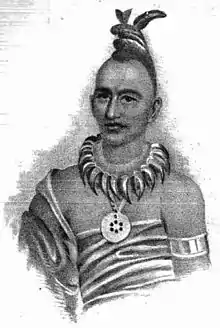
- Appanoose
- Antonine Barada (White Horse)
- Black Hawk
- Douglas Spotted Eagle
- Inkpaduta
- Keokuk
- Mahaska "White Cloud"
- Neapope
- Maria Pearson
- Poweshiek
- Quashquame
- John Raymond Rice
- Sauganash (Billy Caldwell)
- Sidominadota
- Taimah (Tama)
- Wabansi
- Wapello
- Watseka
- Ray Young Bear
- Notchininga "No Heart"[12]
References
- Foster, Lance M. (2009). The Indians of Iowa. Iowa City: University of Iowa Press. ISBN 1-58729-817-1.
- Alex, Lynn M. (2000). Iowa's Archaeological Past. Iowa City: University of Iowa Press. ISBN 978-0-87745-681-0. Archived from the original on 2009-11-20. Retrieved 2009-10-21.
- Peterson, Cynthia L. (2009). "Historical Tribes and Early Forts". In W.E. Whittaker (ed.). Frontier Forts of Iowa: Indians, Traders, and Soldiers, 1682–1862. Iowa City: University of Iowa Press. pp. 12–29. ISBN 1-58729-882-1. Archived from the original on 2009-08-05. Retrieved 2009-10-22.
- Mildred Mott (1938) "The Relation of Historic Indian Tribes to Archaeological Manifestations in Iowa", Iowa Journal of History and Politics 36:227-314.
- Late Prehistoric Oneota Population Movement into the Central Plains, by Lauren W. Ritterbush and Brad Logan. Plains Anthropologist Vol. 45, No. 173, pp. 257-272, 2000.
- "The Milford Site (13DK1): A Postcontact Oneota Village in Northwest Iowa", by Joseph A. Tiffany and Duane Anderson. Plains Anthropologist Vol. 38, No. 145, pp. 283-306, 1993.
- Susan C. Vehik, "Dhegiha Origins and Plains Archaeology", Plains Anthropologist Vol. 38, No. 146, pp. 231-252, 1996.
- Alfred E. Johnson, "Kansa Origins: An Alternative", Plains Anthropologist Vol. 36, No. 133, pp. 57-65, 1991.
- Isaac Galland, 1840, Galland's Iowa Emigrant: Containing a Map, and General Descriptions of Iowa Wm. Jones, Chillicothe
- Colin M., Betts. "Rediscovering the Mahouea". Journal of the Iowa Archeological Society. 58: 23–33.
- Whittaker (2008): "Pierre-Jean De Smet’s Remarkable Map of the Missouri River Valley, 1839: What Did He See in Iowa?", Journal of the Iowa Archeological Society 55:1-13.
- Lance M. Foster The Indians of Iowa 2009. Quote: "The most famous of these maps was presented by Chief No Heart in connection with the treaty of 1837. It showed clearly the antiquity of Ioway villages along most of Iowa's major rivers; the United States decided in favor of the claims of the more numerous and powerful Sioux, Sauk, and Meskwaki. .."

